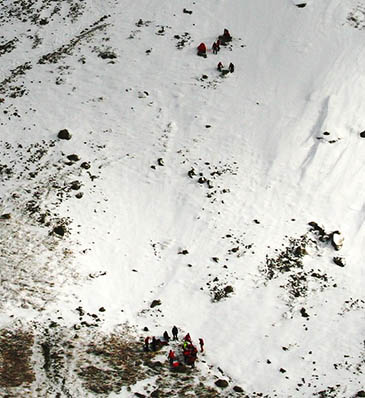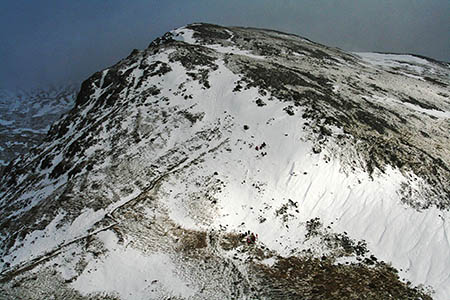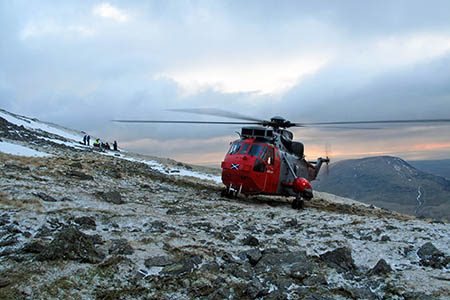A search and rescue helicopter pilot had a day to remember on his final flying stint with the Royal Navy, rescuing five stricken hillgoers in the Lake District in four separate incidents.
Lieutenant Commander Geoff Richardson spent his final flying day rescuing walkers and climbers in one of the busiest days in months on the fells for mountain rescue teams.
Lt Cdr Richardson was one of four crew on the Sea King helicopter based at HMS Gannet in Ayrshire.
The Royal Navy was called into action while on a training exercise near Kilmarnock and flew to Helvellyn where a father and son had been injured after falling on Browncove Crags, north-west of the summit plateau.
A doctor from Glasgow’s emergency medical retrieval team who was on board the helicopter for routine training also had a busy time treating casualties across the Lake District.
Lieutenant Nick Walker was piloting the aircraft alongside Lt Cdr Richardson, with observer and navigator Lieutenant Phil Gamble and Petty Officer Taff Ashman, winchman and paramedic, completing the crew.

A close up of the incident on Browncove Crags, showing two separate groups of rescuers. Photo: Royal Navy
The Great North Air Ambulance aircraft Pride of Cumbria also went to the aid of the walkers and climbers. Keswick Mountain Rescue Team and two members of the Patterdale team were also at the scene.
A Royal Navy spokesperson said: “Due to the location of the casualties, it was necessary to winch the helicopter’s aircrewman and paramedic Petty Officer Taff Ashman onto the hillside, along with Dr McMaison from the EMRT, with a stretcher to package first casualty.
“They then retrieved a second stretcher from the air ambulance, which does not have a winching capability, and returned with the helimed’s paramedic to package the second casualty.”
The father and son were then taken, one each by the Sea King and Pride of Cumbria, to the Cumberland Infirmary in Carlisle. The Sea King then refuelled at Carlisle Airport.
The spokesperson said: “In the meantime, the HMS Gannet crew had been tasked to a second job, this time at Swirral Edge [on Helvellyn] to a fallen walker.
“Arriving on scene they found that Patterdale MRT was attending and that Helimed 58 [air ambulance] was standing by to assist and were immediately retasked to job three of the day – a call to another injured walker, this time on Lord’s Rake, Scafell.
“The helicopter routed to Wasdale to collect MRT and moved the team members close to where the female casualty had fallen.
“Gannet’s winchman Taff and Dr McMaison also assisted with packaging the casualty on a stretcher and the helicopter then routed to Carlisle hospital for its second visit of the day.
“And, by that stage, running low on fuel again, another splash and dash at Carlisle Airport was required.
“Once again, they hadn’t even completed the third job when a fourth tasking came in – for another fallen walker, this time at St Sunday Crag, Patterdale.
“Arriving on scene it was clear that they would have to winch Taff down to get the casualty ready for a winch recovery to the aircraft. Patterdale and RAF Leeming Mountain Rescue Teams reached the casualty at around the same time.”
The man was winched into the Sea King and transferred to the West Cumberland Hospital in Whitehaven.
The HMS Gannet team and Dr McMaison finally arrived back at their Ayrshire base at 7.10pm, after more than six hours of back-to-back jobs. Throughout the afternoon, the team had to contend with freezing conditions and snow showers in all the locations.
Lieutenant Gamble said: “It was quite an unusually busy afternoon for us.
“The winter conditions bring many out into the hills to enjoy the scenery, but sadly sometimes accidents can happen.
“Although none of these jobs was particularly arduous in isolation, cumulatively they added up to quite a long period of time, which requires a fair amount of endurance on the crew’s part.
“But it was good to be able to help all those who needed us and to work alongside all our colleagues in the other emergency services.”
Senior pilot Lt Cdr Richardson is leaving the Royal Navy this year having completed more than 5,000 hours in the air during his career.


Stephen Harrison
25 February 2013These guys are worth their weight in gold.
leninsky
25 February 2013Thank goodness we have these people to be there when we venture into an environment that there's always a risk of danger.
john kinsman
28 February 2013well done lads great work